Inside NYC's Chaotic Timothée Chalamet Lookalike Competition
When flyers for a Timothée Chalamet Lookalike Competition began circulating across New York, cinephiles didn't expect the event


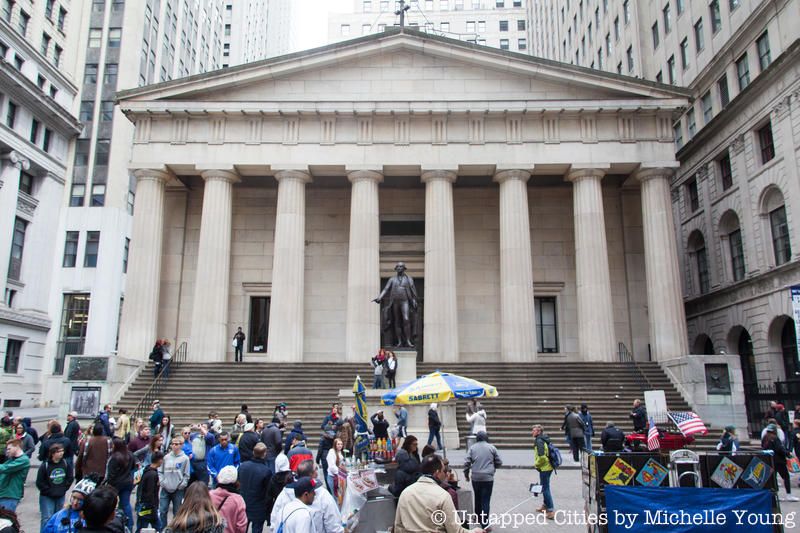
On this day in history, George Washington was inaugurated as the first president of the United States on the balcony of Federal Hall. Over two centuries have passed since then, but we’ll soon be partying like it’s 1789 all over again. During The First Annual George Washington Inaugural Ball at Federal Hall, guests will have the opportunity to try historic food and drink, and enjoy period entertainment! As part of the perks for Untapped Cities Insiders, we were able to grab free spots for the event.
In anticipation for the ball (and in honor George Washington’s legacy, of course), National Park Service volunteer and hostess of the event, Lindsey R. Mullholand, has shared 10 fun facts about his inauguration:

George Washington’s entry into New York. Photo via Wikimedia: The Library of Congress
After being unanimously chosen to be the first President of the United States, former secretary of the Continental Congress Charles Thomson was dispatched to deliver the news to George Washington at his home in Virginia, Mount Vernon.
Thomson left Tuesday, April 7th, 1789 and arrived at Mount Vernon at 12:30pm on Tuesday, April 14, 1789. After being presented with the news, and accepting the position, President elect George Washington, Secretary Charles Thomson and Colonel David Humphreys (his aide-de-camp) set out for New York on April 16, 1789.
His neighbors near Mount Vernon were the first to join the presidential cavalcade as they passed through town. The journey continued to taverns, dinners, banquets and toasts in Alexandria, Georgetown, Bladensburg, Baltimore, Havre de Grace, Charlestown, Elton, Wilmington, Chester, Philadelphia, Trenton, Princeton, New Brunswick, Woodbridge, Rahway (Bridgetown), Elizabeth-Town and Elizabeth-Town Point until boarding a barge rowed by 13 men wearing white uniforms and black caps ornamented with fringes. They were at the oars of the barge, which embarked to Murray’s Wharf at the base of Wall Street in New York City.
The most fascinating accounts are those of the ladies and girls of Trenton. Dressed in white, they sang songs and tossed flowers as George Washington proceeded through a specially-constructed arch in town. Painter Charles Wilson Peale made a similar attempt by covering a bridge and structure of evergreen and laurel at Gray’s Ferry near Philadelphia.
Vice President John Adams had a similar journey made from his home in Braintree, MA; stopping through Hartford, CT and New Haven, CT on his way to New York City.
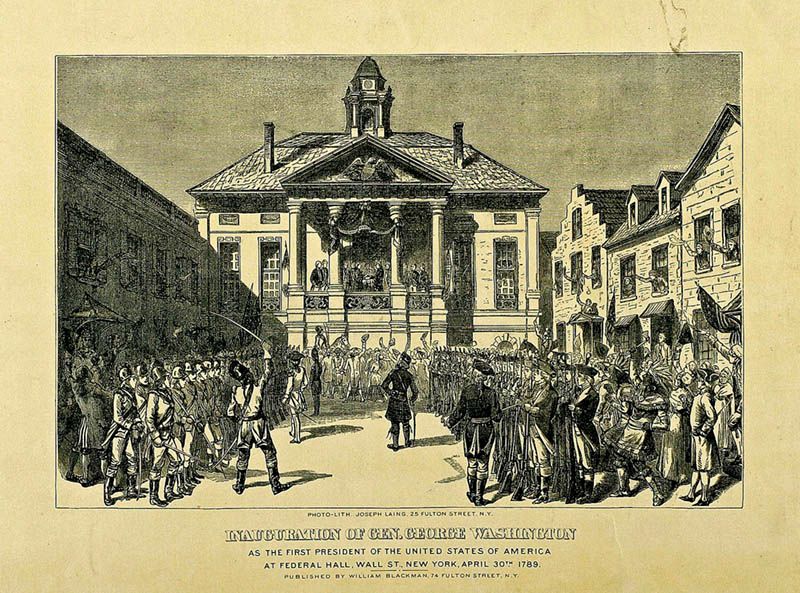
Lithograph by Joseph Laing (1828-1905); published by William Blackman. Image from Wikimedia Commons, public domain
George Washington rode in a coach drawn by four horses and was accompanied by about 500 other officers, regiments, dignitaries and citizens alike. Two impressively dressed grenadier companies and a group of Scottish Highlanders were included in the cavalcade in New York. The first of the grenadiers were young men from New York, dressed in blue with red facings, gold-laced ornaments, cocked hats with white feathers, waistcoats, breeches and white gaitors.
The German grenadier company wore blue coats with yellow waistcoats and breeches, black gaiters, towering, cone-shaped caps and faced with black bearskin. The Highlanders wore their traditional uniforms and played bagpipes.
Once the procession of 500 made it within yards of Federal Hall, they lined up for George Washington and members of Congress to walk through the lines to the “Federal State House”.
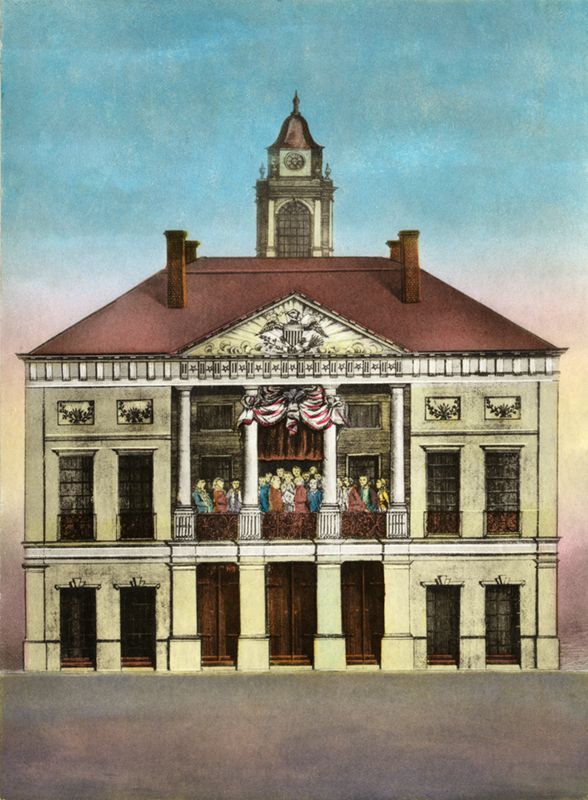
Photo via Wikimedia: Library of Congress
The former building called City Hall was first built in 1700. By 1789, City Hall was in disrepair and needing to be remodeled. Wealthy citizens of New York City raised $32,000 for the purpose of remodeling City Hall into Federal Hall for George Washington’s inauguration in 1789.
Within the 1700-built City Hall were two grand staircases leading to a second floor courtroom; as well as basement cells for prisoners and attic cells for debtors.
Pierre Charles L’Enfant remodeled the building for the 1789 inauguration. The outside and lower portion of the building included a Tuscan style portico with seven openings, with the second floor balcony awning held up by four massive Doric columns. Above the balcony was an image of an eagle with 13 arrows and an olive branch in its talons.
Inside, the Senate Chamber ceilings were 20 feet high; arched and blue, with 13 stars in the center. The Senate room measured 30 feet by 40 feet. Above the President’s chair, which stood upon a 3-foot platform, was a canopy of crimson. The windows were also draped in crimson. Chairs and desks in the room formed a semi-circle. There were three massive windows facing Wall Street, which opened up onto a 12-foot balcony and to the iconic inauguration railing.
The Hall of Representatives was similar, though octangular, 58 feet by 61 feet with an arched ceiling with a desk and chair for each Representative.
The current Federal Hall National Memorial is on the same site as the former City Hall and Federal Hall, and is run by the National Park Service. On its front steps is a large statue of George Washington near or on the place he stood while taking the oath of office. His pose is to represent the moment he brought his hand up from the bible.
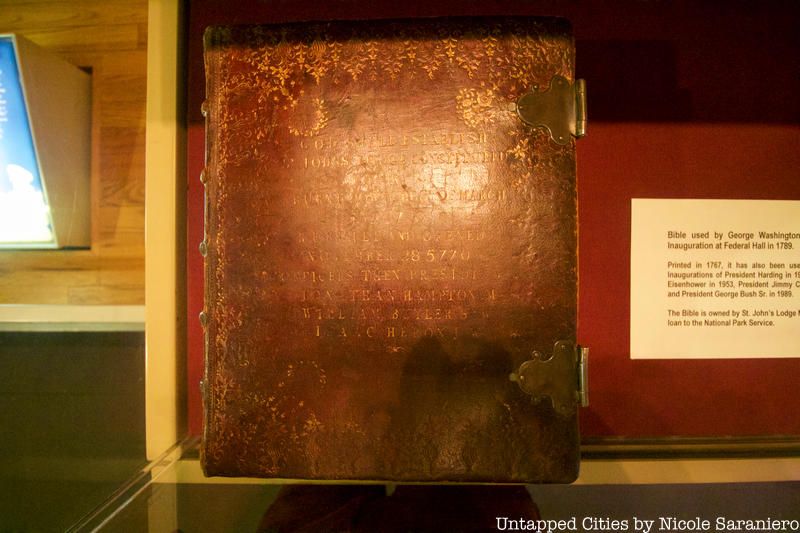
General Morgan Lewis was Marshal of the day. His aid General Jacob Morton, Master at St. John’s Masonic Lodge, brought the bible and red cushion from the lodge. The Masonic bible used for the ceremony is a copy printed in 1767 in London and features a large illustration of King George II.
Robert Livingston, Chancellor of State of New York and Grand Master of Grand Lodge of New York, administered the oath to George Washington. Livingston was one of a committee of five who drafted the Declaration of Independence 13 years earlier.
With his right hand on the bible, Washington repeated the 35 word oath. Adding, “So help me God”, and bent down to kiss the bible. Livingston then shouted “It is done!” and “Long live George Washington, President of the United States!” to the crowd below. The raising of a flag signaled a discharge of artillery from the Battery, cheers and ringing of bells filled the city.
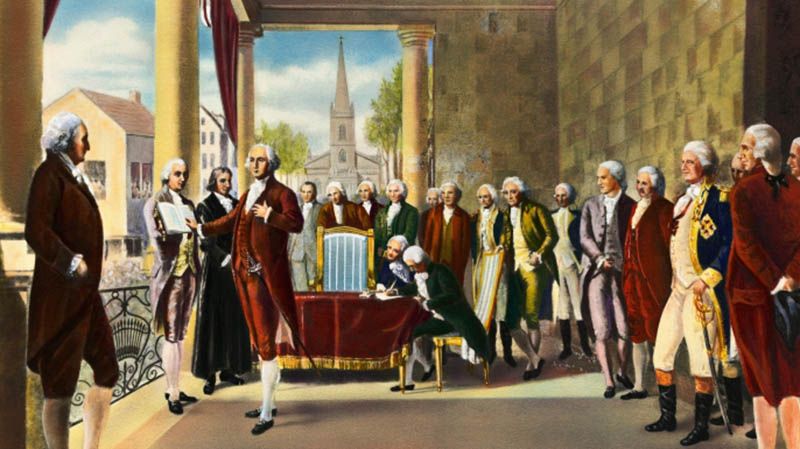
Photo via Wikimedia: public domain
Senators and Representatives wrote that George Washington’s inaugural address featured a nervous speech; so quiet many mentioned having to sit on the edge of their seats to hear him speak.
On the day of the inauguration, he wore a simple brown suit woven from fabric from a mill in Hartford, Connecticut. Silver buttons featuring eagles adorned the suit, as well as white stockings, black shoes with buckles and a steel-hinted dress sword.
Though greeted with a street full of cheering crowds; George Washington never addressed the crowds after taking the Oath of Office; only placing his hand to his heart and bowing several times from Federal Hall’s second story balcony.
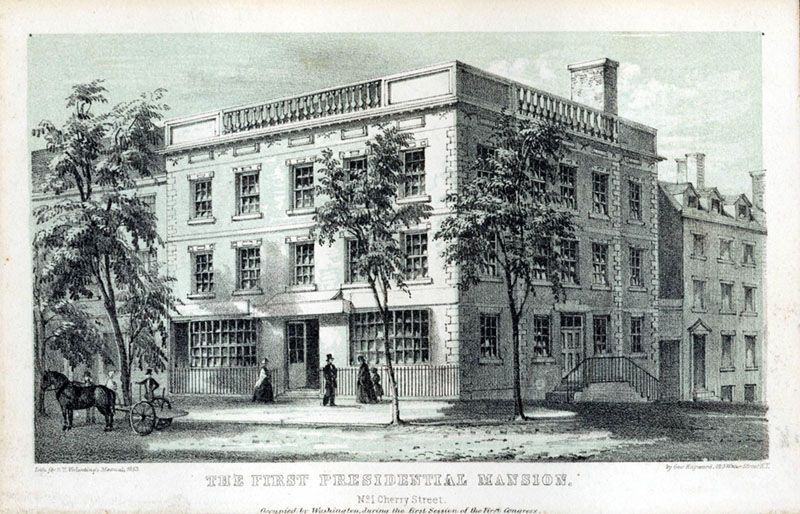
Photo via Wikimedia: The New York Public Library
The first presidential mansion, known first as the Franklin House was located on Cherry Street and built in 1770 by wealthy merchant Walter Franklin. Upon his death, his widow Maria Bowne Franklin became the second wife to Samuel Osgood (a merchant and statesman and postmaster general during George Washington’s first term).
The family vacated the mansion to allow it to serve as the first presidential mansion for the Washingtons. The three-story brick home was decorated by Mrs. Osgood and Lady Kitty Duer. Though the Washingtons felt it was favorable (also shipping their own personal items from Mount Vernon), the French Minister did not. The building was demolished in the 1850s and was located near the site of today’s Brooklyn Bridge.

George Washington at St. Paul’s Chapel. Photo via Wikimedia: public domain
After the morning procession from the Presidential Mansion to Federal Hall, the Inauguration, George Washington’s inaugural address to Congress and services at St. Paul’s Chapel, the city was alight with grand illuminations of the likeness of George Washington, tallow candles in the windows and more. Later that evening, New Yorkers gathered to watch and cheer on an impressive two-hour show of fireworks.
The streets were so crowded after the fireworks display that George Washington walked from the home of Chancellor Robert R. Livingston back to the presidential mansion on Cherry Street.

The Washington Family. Photo via Wikimedia: public domain
The first inaugural ball was held Thursday May 8th, 1789 at the City Assembly rooms about a block north of Wall Street on Broadway. The ball lasted until 2am, and George Washington was noted to have danced in two cotillions and the minuet.
About 300 guests were present. Guests included Vice President John Adams, many members of Congress, the French Minister the Comte de Moustier, the Spanish Charge d’Affaires, Don Diego Gardoqui, Mayor James Duane, Baron von Steuben, General Hamilton, Mrs. Langdon, Mrs. Peter Van Brugh Livingston, Mrs. Livingston of Clermont, Mrs. Chancellor Livingston, Mrs. Gerry, Mrs. Thomson, Mrs. Montgomery, Mrs. Edgar, Mrs. Beekman, Mrs. Dalton, Mrs. McComb, Mrs. Lynch, the Marchioness de Brehan, Lady Stirling and her two daughters Lady Mary Watts and Lady Kitty Duer, Lady Temple, Madame de la Fores, Mrs. Knox, Mrs. Houston, Mrs. Griffin, Mrs. Provoost, the Misses Livingston and the Misses Bayard.
Though Martha Washington missed the ball, she arrived in her own coach to New York on May 27, 1789. With her were her two grandchildren, Nelly Parke Custis and George Washington Parke Custis (who was just eight years old).
She held her first reception on May 29, 1789. Within the drawing rooms and social circle of Martha Washington were Mrs. Jay (Sarah Livingston Jay), Mrs. Adams (Abigail Smith Adams), Mrs. Hamilton (Elizabeth Schulyer Hamilton), Mrs. Robert Morris (Mary White Morris) , Mrs. Ralph Izard (Alice DeLancey Izard), Mrs. Knox (Lucy Flucker Knox), Lady Mary Watts, Lady Kitty Duer, Mrs. Beekman (Jane Keteltas Beekman), Mrs. Provoost (Maria Bousfield Provoost), Mrs. Livingston (Mary Stevens Livingston), Mrs. Elbridge Gerry (Ann Thompson Gerry) and Mrs. Rufus King (Mary Alsop King).
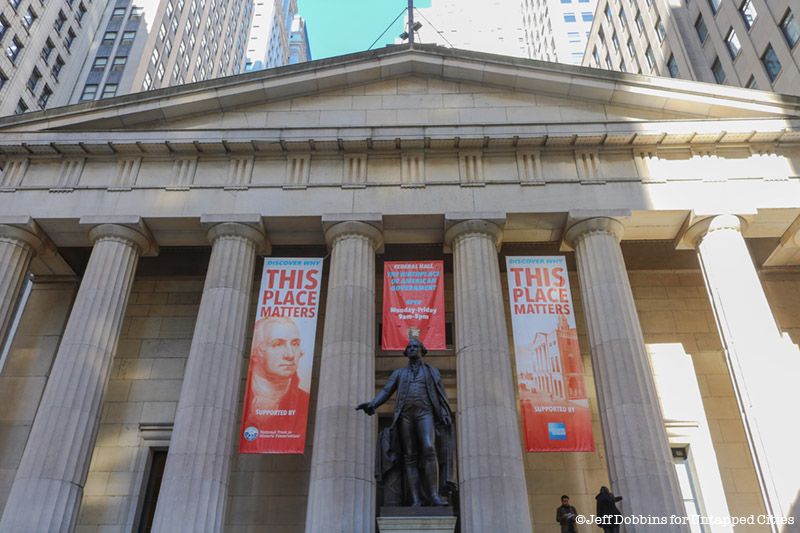
You can visit the site of the first inauguration, see the stone where George Washington stood and see the St. John’s Lodge Masonic Bible at Federal National Memorial at 26 Wall Street. (Disclaimer: often times such iconic pieces of our country’s may be on loan to other institutions.)
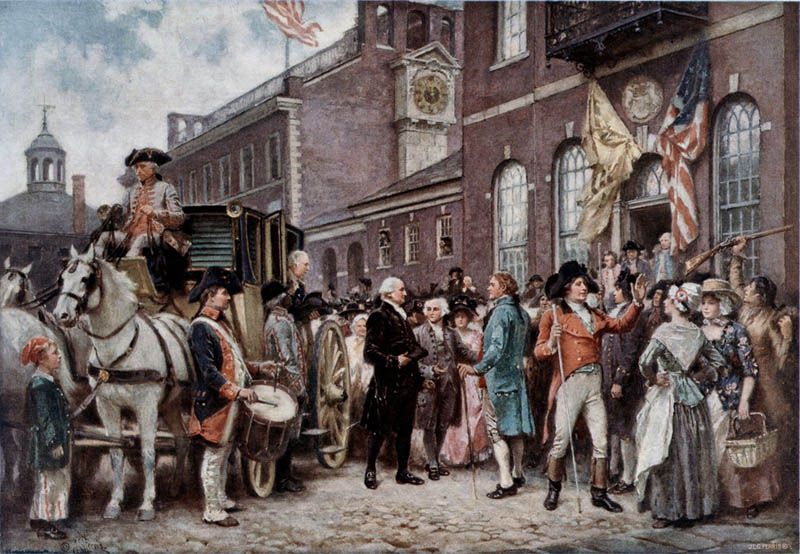
Photo via Wikimedia: Library of Congress
George Washington wasn’t just inaugurated at Federal Hall. His second inauguration took place in Philadelphia, held in the Senate Chamber of Congress Hall on March 4, 1793 for his second four-year term. This was the first inauguration to take place in Philadelphia, which was the nation’s capital at the time. Additionally, Washington delivered what remains the shortest inaugural address to this day at 135 words.

Next, check out George Washington’s Tooth at the Fraunces Tavern and visit 10 Presidential Haunts Across New York City.
Subscribe to our newsletter